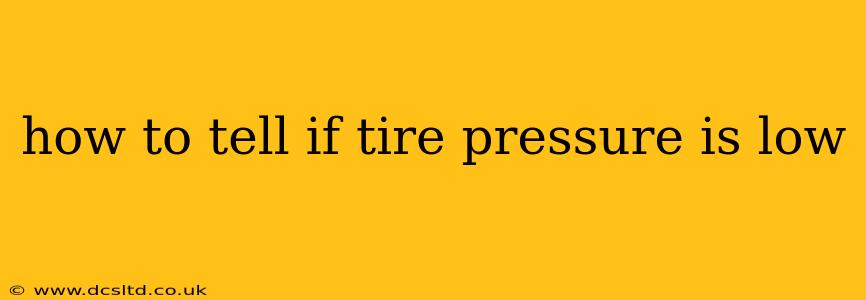Maintaining the correct tire pressure is crucial for safety, fuel efficiency, and tire longevity. Driving on underinflated tires can lead to accidents, reduced gas mileage, and premature wear and tear. Knowing how to check and identify low tire pressure is a vital skill for every driver. This guide will walk you through several methods, addressing common questions drivers have about detecting low tire pressure.
What are the Signs of Low Tire Pressure?
Several indicators can alert you to low tire pressure, even before you use a pressure gauge. These visual and performance cues should prompt you to check your tires immediately.
-
Visual Inspection: Look for visibly flattened or deflated tires. A significantly low tire will be noticeably less inflated than its counterparts. However, a slow leak might only show a slightly flatter profile, requiring a closer examination.
-
Handling Changes: Low tire pressure dramatically affects vehicle handling. You might notice:
- Increased braking distance: It takes longer to stop the car.
- Poor handling and responsiveness: The car feels less stable and responsive to steering inputs.
- Excessive swaying or wandering: The vehicle might feel less stable, especially on curves or uneven roads.
- Vibration: You may feel a noticeable vibration in the steering wheel or through the car's body.
-
TPMS Warning Light: Many modern vehicles are equipped with a Tire Pressure Monitoring System (TPMS). This system alerts you to low tire pressure via a warning light on your dashboard. This light is usually a picture of a tire with an exclamation mark inside. While convenient, it's important to remember that the TPMS might not always detect slow leaks immediately.
How Often Should I Check My Tire Pressure?
Checking your tire pressure regularly is essential for maintaining optimal vehicle performance and safety. It's recommended to check your tire pressure at least once a month, or more frequently in extreme weather conditions (very hot or cold temperatures). Before embarking on a long journey, checking your tire pressure is a must.
What is the Best Way to Check My Tire Pressure?
The most reliable method is to use a tire pressure gauge. You can find these at most auto parts stores, gas stations, and even some supermarkets.
- Using a Tire Pressure Gauge: Make sure your tires are cold (haven't been driven on recently). Unscrew the valve cap on the tire valve stem and press the gauge firmly onto the valve. The gauge will display the pressure in PSI (pounds per square inch). Compare this reading to the recommended pressure listed on a sticker typically found inside the driver's side doorjamb, or in your owner's manual.
What if My Tire Pressure is Low?
If your tire pressure is below the recommended level, add air using a compressor at a gas station or a portable air compressor. Add air slowly to avoid overinflation. Once you reach the recommended pressure, double-check the pressure with your gauge. If the tire continues to lose pressure quickly, you likely have a leak and should consult a tire professional.
How Do I Find My Recommended Tire Pressure?
The recommended tire pressure for your vehicle is usually specified in PSI on a sticker located inside the driver's side doorjamb or in your owner's manual. This sticker may also specify different pressures for front and rear tires, as well as for when the vehicle is carrying a full load. Always check this sticker or your manual for the most accurate information.
What Causes Low Tire Pressure?
Several factors can contribute to low tire pressure:
- Slow Leaks: These can be caused by punctures, damaged valves, or gradual air seepage through the tire sidewall.
- Temperature Changes: Cold weather causes air to contract, resulting in lower tire pressure.
- Driving on Underinflated Tires: Driving on consistently underinflated tires wears them down faster.
Can I Drive on a Tire with Low Pressure?
Driving on a significantly underinflated tire is dangerous and should be avoided. It can lead to a blowout, damage to the tire, and compromise vehicle handling. If you detect low pressure, inflate the tire as soon as possible and drive cautiously to a tire professional or a repair shop for inspection.
This comprehensive guide should help you easily identify low tire pressure and take appropriate action. Remember, regular checks and maintenance are key to safe and efficient driving.
